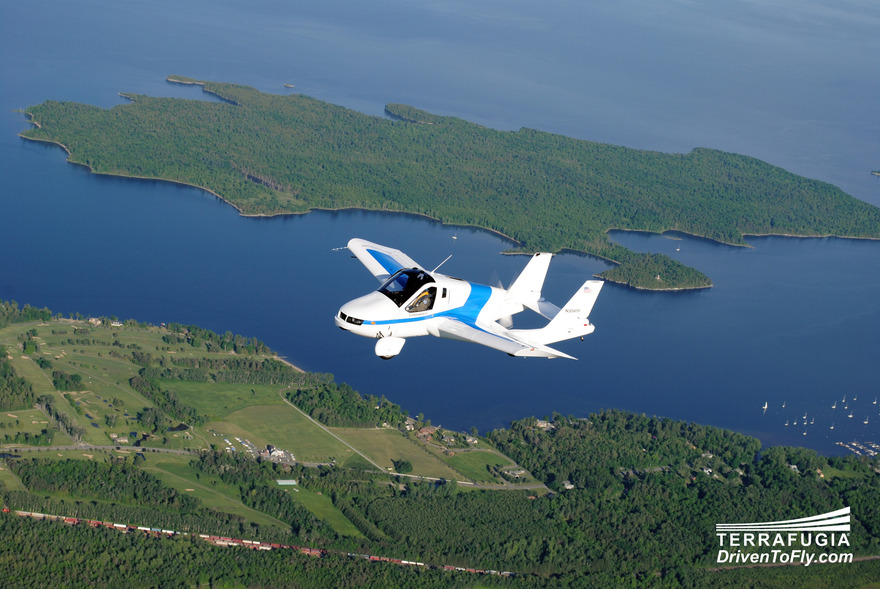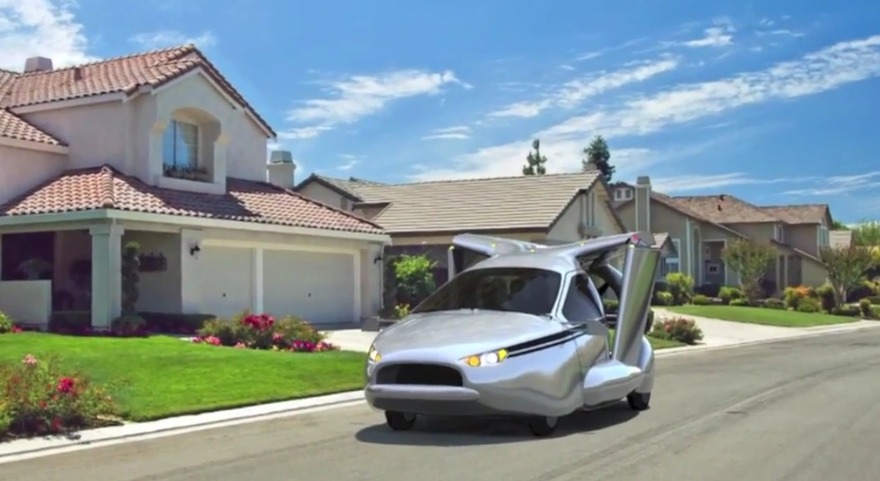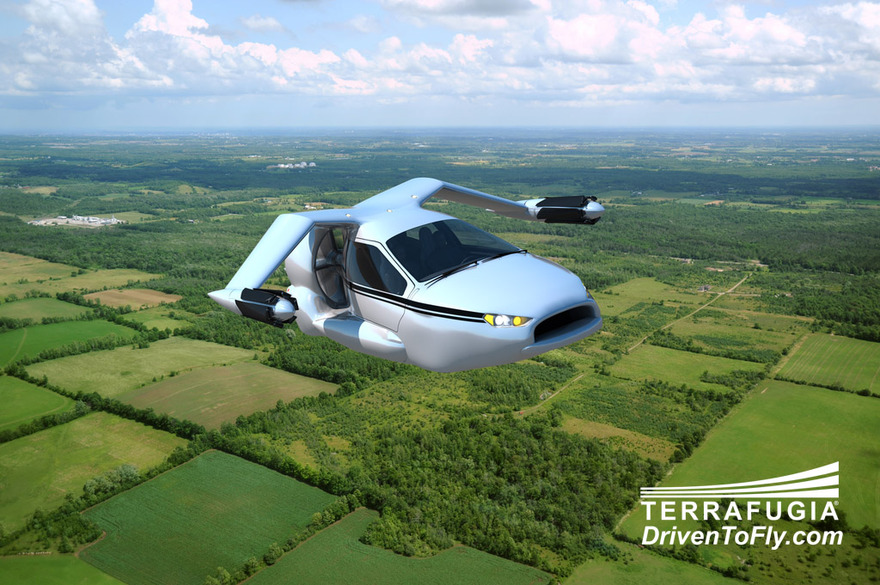Terrafugia TF-X is both a car and a plane… Humankind has been haunted with an idea of adding some extraordinary features to a car for quite a long time. They have already taught it to swim (like a floating sQuba, for instance, we have already told you about), and the only thing left is to teach it to fly. Well, the idea is not new as the first flying car was revealed in Paris back in 1911. It’s just that there has never been any practical need for one.
As years went by the amount of cars on the roads was increasing, more and more huge traffic jams started emerging in large cities causing traffic collapse. People suffer from the economic point of view, while the planet suffers from the ecological point of view. So the time has come for the most desperate “James Bonds” among constructors to put their hands at rescuing the humankind — to invent a car-plane, which saves people from traffic jams and the atmosphere from emissions.
HISTORY, REALITY, FUTURE:
1956
American company Aerocar produced its first Model 1. Its design was inconvenient and imperfect — wings had to be attached to the body before each flight. Later they created an Aerocar, based on the Lotus Elise sports car. However, wings and propeller engine had to be attached manually as well.
2004
An American inventor Paul Moller built an M400 Skycar. The super flying car looked like a Batmobile and was equipped with eight turbines providing a vertical take-off. It is, perhaps, the most boosted version of a flying car as of today, with only one unit produced.
2007
Another vehicle with a vertical take-off function was created. It was a car-helicopter Gyrocopter built by the Dutch engineer John Bakker. In fact, it’s a crossbreed of a helicopter, an airplane, and a motorcycle —propellers are folded away on the road and the vehicle turns into some kind of a two-seat motorbike.
An Australian engineering designer John Brown developed a two-seat Carplane with folding wings — its wheels will be fitted with electric motors and a Subaru engine will be used to power its propellers.
2012
American company Terrafugia produced its first production car-plane Terrafugia Transition. A compact vehicle with folding wings can be fitted into a standard garage. Its price is over €250,000. The most realistic variant.
2013
Potential customers did not like the concept of the Gyrocopter and that is why this project continues its development under the Pal-V name.
2015
John Brown plans to launch production of his development — the flying car Carplane — and sell it at the price of €100,000.
It is obvious that flying cars can make a revolution in the world of car and aircraft manufacturing and pit against aircraft of civil aviation.
But let’s get back to the most realistic variant. First production car-plane Terrafugia Transition is a technically complete model with decent characteristics and an eye-pleasing exterior. This vehicle is intended for wealthy daredevils. Although one should need a pilot's licence for driving this wonder car.
INTERESTING FACTS:
1) The name of the American company Terrafugia is derived from the Latin word for “Escape the Earth”, while the name of the flying car Transition is a synonym to “Transformation”.
2) Development and tests of the Terrafugia Transition attracted sensational interest to the model, so if the idea is cost-efficient, large corporations will be ready to join the process of car-plane manufacturing. As reported by the company, more than a hundred of American citizens have already ordered a flying car in spite of its high price.
3) This flying car is legal to operate only on the territory of the United States, and only if you have a pilot’s license. This type of license can be acquired after paying $4,000, having 30 hours of classes, and passing an examination.
Terrafugia Transition is safer than single-engine aeroplanes, which often have accidents in bad weather conditions. In this case, the Terrafugia Transition can land on any asphalt road and the driver might continue the journey with the help of wheels. Additionally, there is a parachute fitted under the bonnet, which allows air dropping in case of emergency.
To prove the vehicle’s safety, Richard Gersh, Terrafugia's vice president of business development, demonstrated in person an example of a hard touchdown at the speed of 140 km/h. There was absolutely no damaged done to the car-plane and it just continued traveling.
The range of this flying car is incredible — 787 km. In addition to that, its running expenses are much lower than that of a regular low-flying aeroplane.
HOW DOES IT WORK
All you need to do to take off is to get behind the wheel and push the button, there is no need for special technical skills. Terrafugia needs just one minute to “spread its wings” and be ready to fly. Any smooth road surface with a straight section of at least 500 m can serve as a runway. The car’s take-off speed is only 100 km/h. Terrafugia Transition can reach the altitude of 1,500 m. On landing, after pushing another button, the wings fold within one minute.
Modern materials were used to reduce the weight of the vehicle — a carbon-fibre-reinforced body is mounted on a composite plastic frame, while its wheels were borrowed from a popular Vespa scooter. The car has a low curb weight of 440 kg as well as the low load use of 210 kg (including a passenger and luggage).
In spite of its flying abilities, Terrafugia Transition is marketed more like a car, than an airplane. Although the road driving mode of Terrafugia might seem a bit unusual. A car-plane is fitted with a traditional steering wheel with airbags.
The powerplant features an Austrian-sourced, four-cylinder boxer Rotax 912 ULS engine with a capacity of 1,350 cc, delivering 100 hp and 128 Nm of torque at 5,100 rpm. The top land speed of the vehicle is only 112 km/h, while its top air speed is much higher — up to 185 km/h.
The engine uses regular 95-octane fuel so this wonder car-plane can be filled with regular petrol at the regular fuel station. It's equipped with an 87-litre fuel tank. The car consumes 6.7 litres on the ground and 13 litres in the air. When comparing the car-plane with single-engine aeroplanes powered by aircraft fuel, experts record up to 50% of fuel economy.
An ecological issue was also raised at Terrafugia. The company built the Terrafugia TF-X model based on the Transition. It’s the world’s first flying hybrid, even more compact and boasting of even more moderate consumption.
A “hybrid” has two meanings here. The TF-X is both a car and an airplane. Moreover, it combines two types of engines — a combustion engine and an electric motor. Thanks to its petrol-powered engine and two vertically exposed propellers, the Terrafugia TF-X can get off the ground from a standing start, and then, with the help of the electric motor and a horizontal turbine, actually travel in the air.
The overall horsepower of the Terrafugia TF-X’s engines is 500 hp, while its top air speed is 322 km/h. Flying range with full tank of fuel and fully charged batteries remains the same — about 800 km.
To put the project of the world’s first flying hybrid TF-X into action, Terrafugia has already begun raising money from potential customers. On the company’s official website, the latter are offered to deposit $10,000. An estimated price of a hybrid car-plane will be around $279,000. Terrafugia promises to complete development of this hybrid in 5–10 years.
INTERESTING TO KNOW:
People are incarnating their vision of flying cars in films and books:
— in the end of the French film “Fantomas Unleashed” the main character escapes in style, using his Citroën DS with retractable wings that converts into an airplane;
— a flying car De Lorean DMC-12 (which is also a time machine) is starring in the film trilogy “Back to the future”;
— in “The Fifth Element” film flying cars are used as city transportation;
— both in the novel and in the film “Harry Potter and the Chamber of Secrets” Harry Potter and Ron Weasley used an enchanted flying car Ford Anglia to get to Hogwarts;
— in the Russian film “Black Lightning” the main character drives a flying Volga GAZ-21 powered by nano-fuel;
— race car of the main character in the “Taxi 2” film can reach top speed of more than 300 km/h and is equipped with retractable wings; however, it can take off only if its speed is high enough;
— Flint Lockwood, the main character of the animated film “Cloudy with a Chance of Meatballs” (2009), a young unappreciated genius scientist, flies to fix the deranged Food Replicator in his Flying Car 2, which is actually a jet-propelled car with wings.
Well, to sum it up, it’s an amusing toy for millionaires with pilot’s license.












